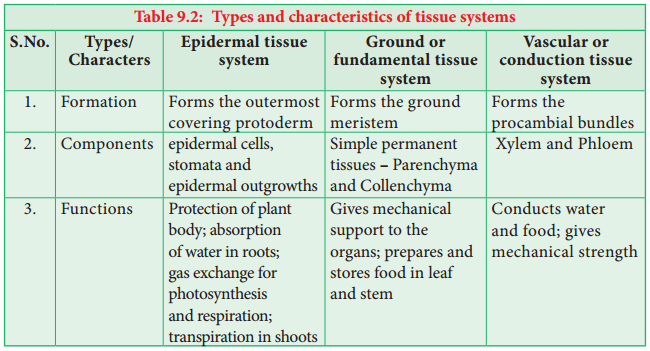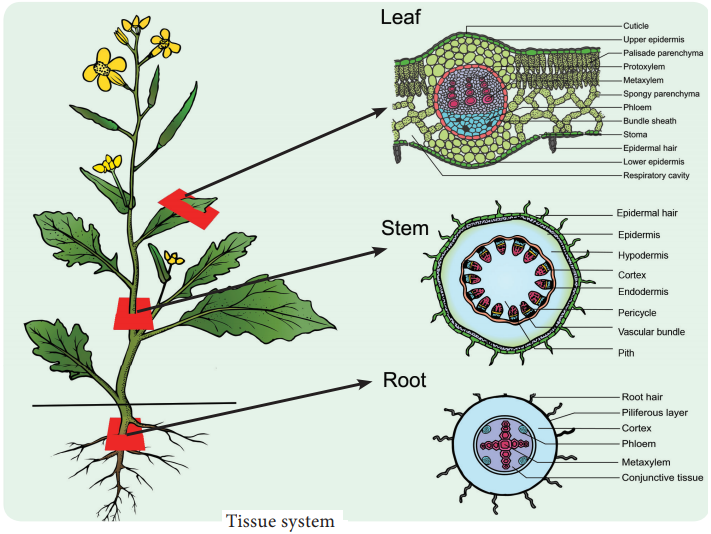Learninsta presents the core concepts of Biology with high-quality research papers and topical review articles.
The Tissue System Types and its Characteristics
Introduction to Tissue System, Types and Characteristics of Tissue System
As you have learnt, the plant cells are organised into tissues, in turn the tissues are organised into organs. Different organs in a plant show differences in their internal structure. This part of chapter deals with the different type of internal structure of various plant organs and its adaptations to diverse environments.
A group of tissues performing a similar function, irrespective of its position in the plant body, is called a tissue system. In 1875, German Scientist Julius Von Sachs recognized three tissue systems in the plants. They are:
- Epidermal tissue system (derived from protoderm)
- Ground tissue system (derived from ground meristem)
- Vascular tissue system (derived from procambium)

In plant anatomy, tissues are categorized broadly into three tissue systems: the epidermis, the ground tissue, and the vascular tissue.
Epidermis:
Cells forming the outer surface of the leaves and of the young plant body.
Vascular Tissue:
The primary components of vascular tissue are the xylem and phloem.
Plant cells are formed at meristems, and then develop into cell types which are grouped into tissues. Plants have only three tissue types:
- Dermal
- Ground and
- Vascular
Dermal tissue covers the outer surface of herbaceous plants.
There are three types of tissue systems:
Dermal, Vascular, and Ground.
The vascular system consists of complex tissues, the phloem and the xylem. The xylem and phloem together constitute vascular bundles. When xylem and phloem within a vascular bundle are arranged in an alternate manner on different radii, the arrangement is called radial. Example – roots.
Simple permanent tissues are composed of cells which are structurally and functionally similar. These tissues are made up of one type of cells. A few layers of cells beneath the epidermis are generally simple permanent tissue. Simple Permanent tissues are divided into two types.
While epidermal tissue mediates most of the interactions between a plant and its environment, ground tissue conducts the basic functions of photosynthesis, food storage, and support.
Tissues are groups of cells that have a similar structure and act together to perform a specific function. There are four different types of tissues in animals: connective, muscle, nervous, and epithelial.
- It protects the organs from injury or shocks
- It also connects many body parts such as ligament connects bones to another bones
- It also provides nutrition to our body such as blood also transport nutrients to many parts of the body
- It fights against many infectious pathogens
Plant tissue systems fall into one of two general types:
Meristematic tissue, and Permanent (or non-meristematic) tissue.
Plant tissues come in several forms: vascular, epidermal, ground, and meristematic. Each type of tissue consists of different types of cells, has different functions, and is located in different places.
Connective tissue is the most abundant tissue type in our body. It connects other cells and tissues together. It is typically found in our bones, cartilage, adipose, collagen, blood and many other areas in our body. This shows that connective tissue is very important in providing support and protection in our body.
These tissues are made up of living cells with thin cell walls which are loosely packed to accommodate the intracellular space. The cells of parenchyma permanent tissue are generally round or oval in shape. The cell wall of parenchyma is made up of cellulose and consists of vacuoles and a nucleus.
They differentiate into three main types: dermal, vascular, and ground tissue. Dermal tissue covers and protects the plant, and vascular tissue transports water, minerals, and sugars to different parts of the plant.
A tissue is an ensemble of similar cells and their extracellular matrix from the same origin that together carry out a specific function. Organs are then formed by the functional grouping together of multiple tissues.
Tissue is a group of cells that have similar structure and that function together as a unit. A nonliving material, called the intercellular matrix, fills the spaces between the cells. There are four main tissue types in the body: epithelial, connective, muscle, and nervous.
